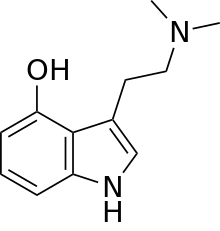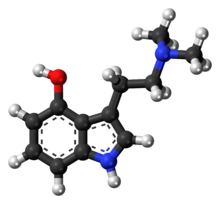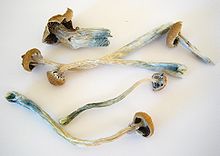Psilocin
 | |
 | |
| Clinical data | |
|---|---|
| Other names | 4-hydroxy-N,N-dimethyltryptamine |
| Routes of administration | Oral, IV |
| ATC code |
|
| Legal status | |
| Legal status |
|
| Pharmacokinetic data | |
| Metabolism | Hepatic |
| Elimination half-life | 1-3 hours[2] |
| Excretion | Urine |
| Identifiers | |
| |
JSmol) | |
| Melting point | 173 to 176 °C (343 to 349 °F) |
| |
| |
| | |
Psilocin (also known as 4-HO-DMT, 4-hydroxy DMT, psilocine, psilocyn, or psilotsin) is a
Chemistry
Psilocin and its phosphorylated cousin,
Psilocin can be obtained by
Psilocin is relatively unstable in solution due to its
Structural analogs
Pharmacology
Psilocin is the pharmacologically active agent in the body after ingestion of psilocybin or some species of psychedelic mushrooms.
Psilocybin is rapidly dephosphorylated in the body to psilocin which acts as a
Psilocin has no significant effect on
Psilocin's half-life ranges from 1 to 3 hours.[2]
Behavioral and non-behavioral effects
This section relies largely or entirely upon a single source. (September 2022) ) |

Its physiological effects are similar to a
There has been no direct lethality associated with psilocin. and other 5-HT2A, 5-HT2C, and 5-HT1A agonists due to down-regulation of these receptors.
Legal status
The United Nations Convention on Psychotropic Substances (adopted in 1971) requires its members to prohibit psilocybin, and parties to the treaty are required to restrict the use of the drug to medical and scientific research under strictly controlled conditions.
Australia
Psilocin is considered a Schedule 9 prohibited substance in Australia under the Poisons Standard (October 2015).[17] A Schedule 9 substance is a substance which may be abused or misused, the manufacture, possession, sale or use of which should be prohibited by law except when required for medical or scientific research, or for analytical, teaching or training purposes with approval of Commonwealth and/or State or Territory Health Authorities.[17]
Russia
Psilocin and psilocybin are banned in Russia, due to their status as narcotic drugs, with a criminal penalty for possession of more than 50 mg.[18]
See also
References
- ^ Anvisa (2023-07-24). "RDC Nº 804 - Listas de Substâncias Entorpecentes, Psicotrópicas, Precursoras e Outras sob Controle Especial" [Collegiate Board Resolution No. 804 - Lists of Narcotic, Psychotropic, Precursor, and Other Substances under Special Control] (in Brazilian Portuguese). Diário Oficial da União (published 2023-07-25). Archived from the original on 2023-08-27. Retrieved 2023-08-27.
- ^ S2CID 10758314.
- PMID 36430546.
- ^ "List of psychotropic substances under international control" (PDF) (23rd ed.). Vienna Austria: International Narcotics Control Board. August 2003. Archived from the original (PDF) on 4 February 2012. Retrieved 2012-10-11.
- PMID 30685771.
- .
- S2CID 220599227.
- PMID 31725937.
- .
- ^ CH 421960, Hofmann A, Troxler F, issued 1967; CA 68:95680n
- ^ PMID 16061378.
- ^ ISBN 978-0-02-328764-0.
- ^ Jerome L (March–April 2007). "Psilocybin Investigator's Brochure" (PDF). Retrieved 2012-10-11.
- PMID 27454674.
- ^ Assessing Drug Risks: A Scientific Framework. European Monitoring Centre for Drugs and Drug Addiction. Luxembourg: EMCDDA. 2016.
- PMID 26841800.
- ^ a b "Poisons Standard". Therapeutics Goods Administration, Department of Health. Australian Government. October 2015.
- ^ "On approval of significant, large and particularly large amounts of narcotic drugs and psychotropic substances, as well as significant, large and particularly large sizes for plants containing narcotic drugs or psychotropic substances, or parts thereof, containing narcotic drugs or psychotropic substances for the purposes of articles 228, 228.1, 229 and 229.1 of the Criminal Code of the Russian Federation (as amended) (translated)". Resolution of the Government of the Russian Federation. Criminal Code of the Russian Federation. 1 October 2012. 1002. Retrieved 1 April 2018.
